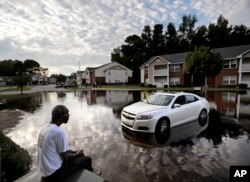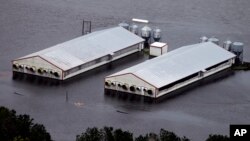Hurricane Florence continued to punish North and South Carolina Thursday a week after it churned over parts of the U.S. eastern seaboard with historically heavy rains and sweeping winds.
About 10,000 frustrated and exhausted people remain in shelters as forecasters predict flooding from swollen rivers will worsen in the two states over the next several days.
The National Weather Service said some major waterways in the Carolinas and Virginia are far above flood stage and are expected to rise for days before they crest.
"People in flood prone areas or near waterways need to remain alert as rivers crest and stay above their banks in coming days," North Carolina Governor Roy Cooper said in a written statement. "Stay alert and stay safe."
Florence, which killed at least 36 people, dumped up to 91 centimeters of rain on parts of North Carolina, where many areas remain cut off by flooding. Access to the North Carolina port city of Wilmington, which was completely cut off by high water for days, has improved, but officials said they didn't know when evacuees would be able to return home.
The storm knocked out power to more than 2.1 million people in the southeastern U.S. and about 120,000 homes and businesses were still without power Thursday in North Carolina, utility companies said.
As floodwaters keep rising, so too are concerns over environmental and health dangers created by contaminated water. The state Department of Environmental Quality said flooding has caused several dozen hog waste lagoons in North Carolina to overflow, releasing contaminants into waterways.
North Carolina's hog industry, among the nation's largest, absorbed its biggest hit from floodwaters in nearly two decades, industry officials said.
North Carolina authorities said 5,500 hogs and nearly 3.5 million chickens were killed by the flooding, which could have damaged up to 57 million kilograms of tobacco worth as much as $350 million.
President Donald Trump declared parts of the Carolinas disaster areas last week, freeing up federal funds for recovery efforts.
Trump got a first-hand view of recovery efforts during a visit to the two states on Wednesday, when he said "the money will be a lot, but it's gonna come as fast as you need it."



